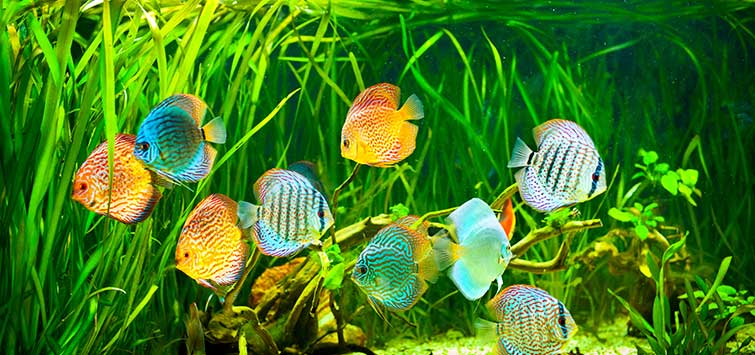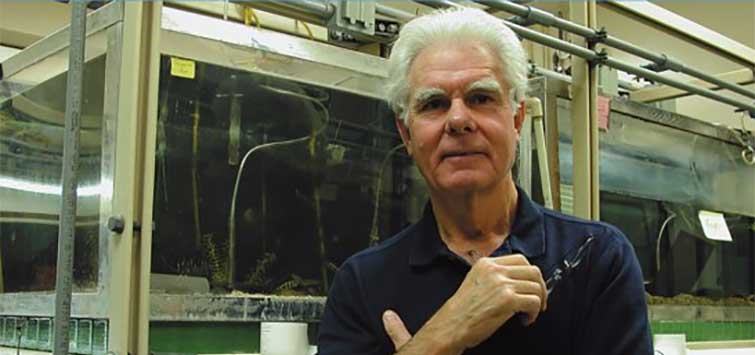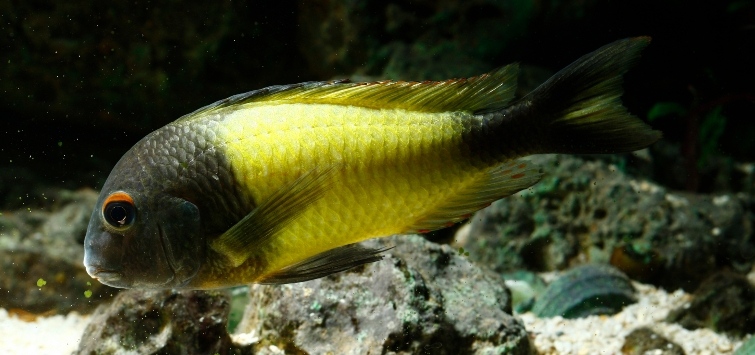From Goldfish Bowl to Planted Discus Tank: My Life With Fish
Author: Andy Rich
A veteran fish hobbyist and plant entrepreneur relates his lifetime experiences, from a modest childhood goldfish bowl to an elaborate and effective hi-tech planted discus setup.
A Hobby 60 Years in the Making
My interest in fishkeeping goes back many years to an age nearly 60 years ago, when having pet fish meant having a glass bowl with one goldfish. I can remember sitting and watching this fish that sat on a windowsill with sunlight reflecting through the glass. I loved that fish so much that I decided to share my milk and cookies with it. That was the end of that experience.
From Fishbowl to Aquarium
Fast forward a few years to when tropical fish hobbyists had only a small selection of 10- and 20-gallon tanks to choose from, and filters were driven by air pumps, with carbon and rock wool as the media. Lighting was provided by everyday incandescent light bulbs. Regardless, I was fascinated with tropical fish. Living in a rural farming community, I remember traveling 20 or 30 miles to buy guppies, swordtails, pink kissing gouramis, neon tetras, and catfish, hoping that they would make the trip back home. I became completely enthralled with the breeding and birthing experience, and soon had several aquariums brimming with fish—they were guppies, of course.
During this same period I became very interested in horticulture, plant propagation, and greenhouse management. At 12 years of age, I built (with my father’s help) a 60-foot greenhouse in which I propagated and then sold a myriad of annual flowers, vegetables, and exotic tropical plants. I was in the plant business.
Therefore it is consistent that this interest in plants spilled over to my aquariums. Given the limited access to fish stores, many of my early plants came from local ponds and streams. In reality, they were weeds, but in my eyes they were beautiful and created a fascinating environment for the fish. Of course, as I was able to visit any fish stores, I bought true aquarium plants. Even so, most plants, as I recall, were limited to stem plants that were easily grown under incandescent lighting.
In, Out of, & Back into the Hobby
I left the hobby behind when I went off to college and then into the military. However, when I got married, aquariums crept back into the decorating theme of our home: a one bedroom apartment. Nestled in a corner of the main living area that served as a living room, dining area, and kitchen stood three 20-gallon tanks that were flanked with exotic, tropical potted plants. My new wife thought that I was nuts, but soon found the livebearing process of guppies and swordtails fascinating and tolerated the constant humming of air pumps and the swishing sound of airstones. She would admit that this living art created a soothing and tranquil environment, and it became an interesting and dynamic focal point in our life and home.
My career in corporate America soon disrupted our lives and moved us several times over the next 25 years. Aquariums and fishkeeping were left behind as we had children and developed other interests. Looking back, I don’t really know why I didn’t create the same goldfish experience for my kids that I had at a very early age. In retrospect, it probably had a lot to do with the hassle factor of the hobby; certainly, picking up the family and relocating every two or three years had a lot to do with it as well. Keeping fish is not a portable hobby.
Back to Fish
Four years ago, my career brought me to a manufacturer of consumer products focused on items for pet owners and garden enthusiasts, including several different brands of the world’s most well-known aquatics products, so I was just like a little kid in a candy store. I knew at that point that I had to get back into the hobby.
The challenge was how to re-enter it, as the world that I remembered from 25 years earlier had changed considerably. The technology and range of products had morphed into something that I no longer understood. My own lifestyle had changed and I knew that my wife would not tolerate having a nest of 20-gallon tanks in our den or living room. The focus of the hobby itself seemed to have shifted to the more interesting and glamorous saltwater segment. I knew then, and still know now, that I understood nothing about saltwater fish and maintaining a marine environment.
Knowledge and Experience
Fortunately, I am surrounded by experts, and my access to their knowledge and information is unlimited. Experts within the company, along with consultants like Jeff Turner of Reef Aquaria Design, Inc., and Roger Degregori of Aquarium Environments, Inc., have provided volumes of information, knowledge, and experience. Access to all of this knowledge and opinion has, at times, proven overwhelming and daunting. Everyone I speak with has their own point of view on what is best. The range of possibilities in equipment is only limited by one’s budget. In fact, the range of filtration equipment alone is huge—and then there’s lighting. All of this is confusing for the entrant or re-entrant to the hobby. What kind of fish? Salt or freshwater? Marine or reef? There is also the seemingly ubiquitous opinion that salt reigns supreme.
With access to some of the best brands in aquatics, I knew that what I wanted to do had to be spectacular. I wanted to create living art for my home. To narrow the range of possibilities, I attended various trade shows and visited retailers known for their expertise, such as North Dallas Aquariums and All About Fish in Concord, California. I had lengthy discussions with Jeff Turner and Roger Degregori. It was during this investigative research that I learned of discus and how beautiful and interactive they are. I knew almost immediately that I wanted a discus tank—a planted discus tank, of course.
Plants & Discus
For discus breeders and hobbyists, this is often an oxymoron. It is simply not possible, according to some of the most experienced discus-keepers. The limited water-quality tolerance of discus makes this difficult even for the most experienced fishkeeper. And the 85°F water temperature required for discus will make it very challenging or impossible for plants. Personally, I love a challenge and the gauntlet was laid down.
Choosing an Aquarium
For my living art project, I needed a location in my home that my wife would not only agree to but also one in which I could replicate Amazon River ecology as near-authentically as possible. We ultimately decided that we should use it as a room divider to create two different living spaces, both with visual access to the aquarium. This meant that it couldn’t be up against a wall, and as a result, everything needed to be plumbed through the bottom. To accomplish this, I worked with some of my colleagues to create a 110-gallon double-bowfront aquarium with iron-free optically clear glass. Holes were drilled to service the aquarium from the cabinet below.
Filtration
Filtration came next. This is by far the most critical component. Here, too, various opinions abound as to the right sizing and hourly capacities. After several disappointments, I have come to the conclusion that there is no such thing as too much filtration. At the end of the day, fish and tank health is all about having adequate filtration. An additional consideration that entered the decision-making process was the ever-increasing cost of this project. Therefore I decided to have two completely redundant filtration, heating, and UV sterilizing systems in the event of a component failure, so I would not risk losing the whole tank. Given the need to plumb everything through the bottom of the tank, filters with sufficient power to move sufficient water volume through filter, heater, and sterilizer were mandatory. For this task, I have used a large canister filter with an oversized pump.
Lighting
The next challenge was the lighting and dealing with the 30-inch depth of the tank itself. There was too little lighting to support the plant life, and much of it was at the wrong light-spectrum wavelength, resulting in huge algae problems. After almost a year of trial and error and through an expensive process of elimination, I decided upon a 4-foot system with two 150-watt metal halide lamps at 6500K and two 96-watt power compact fluorescent lamps. In the end, this yielded amazing results.
Success
Falling back on my early-life interest in plants, I decided to start the tank initially with water chemistry and temperatures (75°F) that would be conducive to a healthy planted tank, and slowly migrate to an environment that would be supportive of discus and other Amazon River fishes. This process took several months to complete and was complicated by my need to have a plant selection that’s unique and representative of a range of textures and colors. Using this acclimatization approach was wise and has resulted in minimal loss of plant life. Clearly there are plants that will survive above 80°F, but there are few that can thrive at those temperatures. Today, the plants are thriving and create an ongoing gardening challenge, particularly with a system supplementing CO2.
Tankmates & Stocking
Along the way, fish were added to begin the necessary ecological balancing act and nitrogen cycle. While trying to stay true to an Amazon River theme, fish that are unique, interesting, and compatible with discus tended to rule the day. Since my objectives were to have a planted discus tank where the discus were the centerpiece, it was important that the other tank inhabitants serve a purpose in supporting the ecological balance. Algae eaters, bottom cleaners, and leaf preeners were added. Just about every article you may read regarding community discus tanks will recommend the cardinal tetra. Why, I don’t know, because this has to be the most delicate fish in the world. Without exaggeration, I have gone through 400 cardinals to get to two dozen—and this was with perfect water chemistry.
And last comes the discus. An associate recommended a particular breeder in Baltimore, and these have to be some of the most beautiful fish I have ever seen—very healthy too. I was skeptical that the discus could endure a 3000-mile cross-country trip, but my fears were belayed after opening the shipping container and acclimatizing the fish. All made it and all are healthy today, two years after their arrival. Among the six are two breeding pairs that tend to be quite active, spawning every three to four weeks. We have been fortunate to have a few eggs hatch, but in a community tank, these are eventually discovered and eaten.
Maintenance
I do all of my ongoing maintenance. On a nearby patio, I have a reverse osmosis (RO) system set up for the weekly and occasional twice-weekly water changes. The system is simply connected to a standard garden hose outlet, and the processed water is stored in a 44-gallon plastic garbage can with an automatic shut-off float valve. I use a supplement to replace necessary minerals removed during the RO process, and an automatic water make-up system is also attached to make up for daily water evaporation. This consists of a simple diaphragm pump connected to a digital timer and a small-diameter plastic water line that runs under the house and up through a small hole drilled beneath the aquarium cabinet. Two 150-watt submersible heaters are in the holding tank to equalize temperatures with the aquarium. Total time on weekly water changes and general maintenance is less than one hour.
Living Art
Three years after starting this journey, I have to say that it has been worth it. I will have an occasional problem usually brought on by a water quality issue, but for the most part it has been problem free. The greatest satisfaction comes when friends or neighbors visit just so they can stand and become mesmerized with our work of living art. It is pretty cool, and many even mistake it for a saltwater system, because it is so beautiful.
Equipment:
110-gallon Oceanic custom tank with Starphire glass
Oceanic cherry-stained oak cabinet
Coralife Aqua Pro Lighting with two 150-watt metal halide lamps and two 96-watt color compact-fluorescent fixtures
2 EHEIM 2260 canister filters
2 Hydor in-line 300-watt heaters
2 Coralife in-line 36-watt UV sterilizers
1 Aqua Medic in-line CO2 diffuser
1 Coralife RO system with 100-gallon-per-day output
Fish/Invertebrates:
5 discus Symphysodon sp.
24 to 30 cardinal tetras Paracheirodon axelrodi
5 flying foxes Epalzeorhynchos kalopterus
1 yoyo loach Botia almorhae
12 cory catfish Corydoras sp.
3 albino bushynose lyretail plecos Ancistrus sp.
200 Caridina sp. “Amano” shrimp
Plants:
Aponogeton crispus
Madagascar lace plant Aponogeton fenestralis
Marimo balls Cladophora aegagrophila
Crinum calamistratum
Crinum thaianum
Cryptocoryne wendtii (red)
Echinodorus sp. “Rubin”
Ludwigia repens x “palustris”
Ludwigia inclinata (Cuban ludwigia)
Myriophyllum sp.
Nymphaea stellata “versicolor”
Rotala macrandra (narrow-leaf)
Vallisneria americana
Vallisneria spiralis
See the full article on TFH Digital http://www.tfhdigital.com/tfh/200806/#pg127

.png?h=595&iar=0&w=2781&hash=5FD5E69473BCC22199FBFA2FB71B6033)



